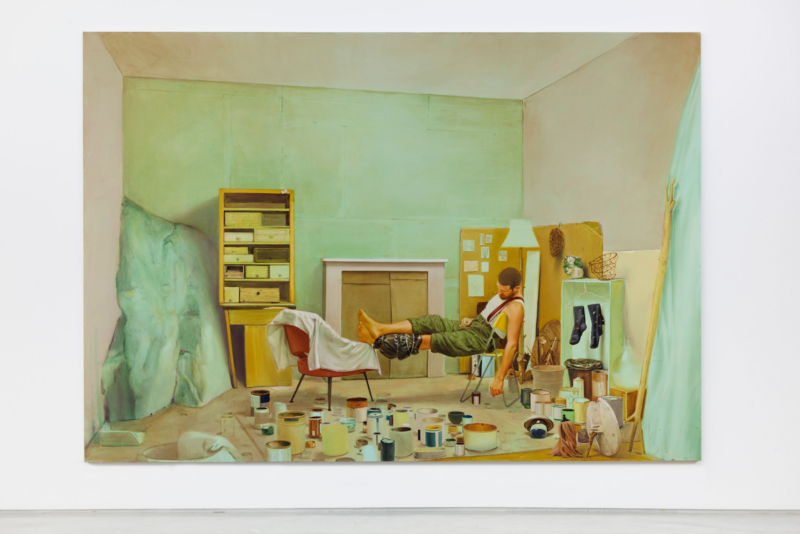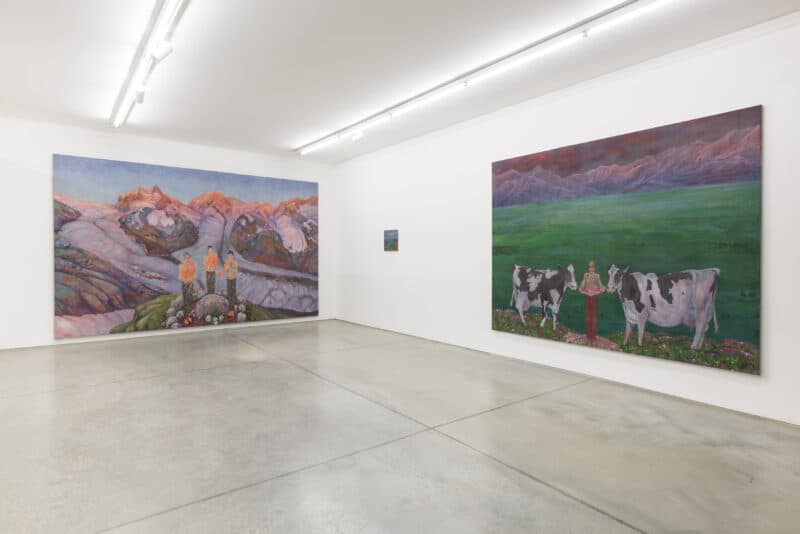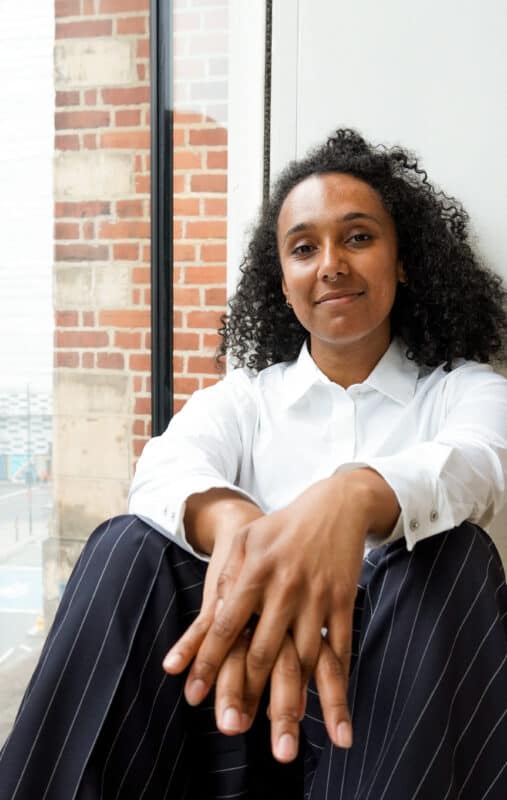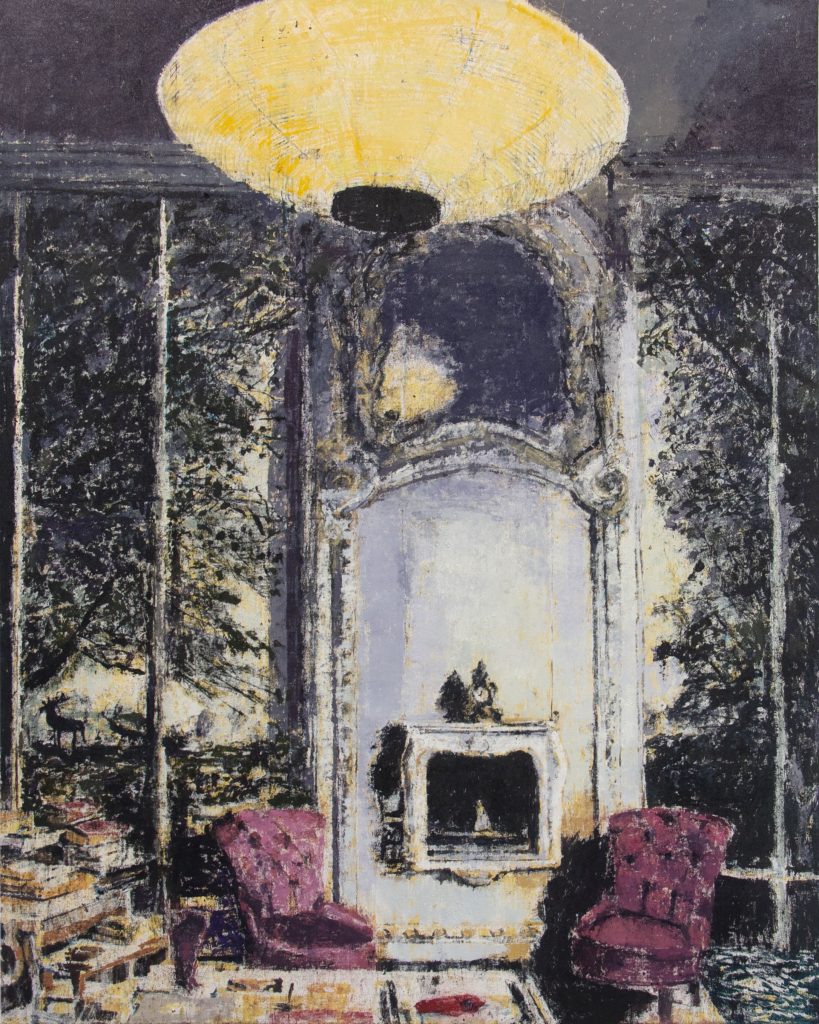
Enoc Perez 2 via Giovanni Francesco Napione, Turin Casa Mollino 2018 olio su tela / oil on canvas 254 x 203,4 cm © Enoc Perez
Drawing inspiration from the Fotografia Europea 2020 theme “Fantasies: Narratives, Rules, Inventions,” Collezione Maramotti, in collaboration with Casa Museo Mollino, is presenting an exhibition that brings together paintings by Enoc Perez and photographs by Brigitte Schindler and Carlo Mollino.
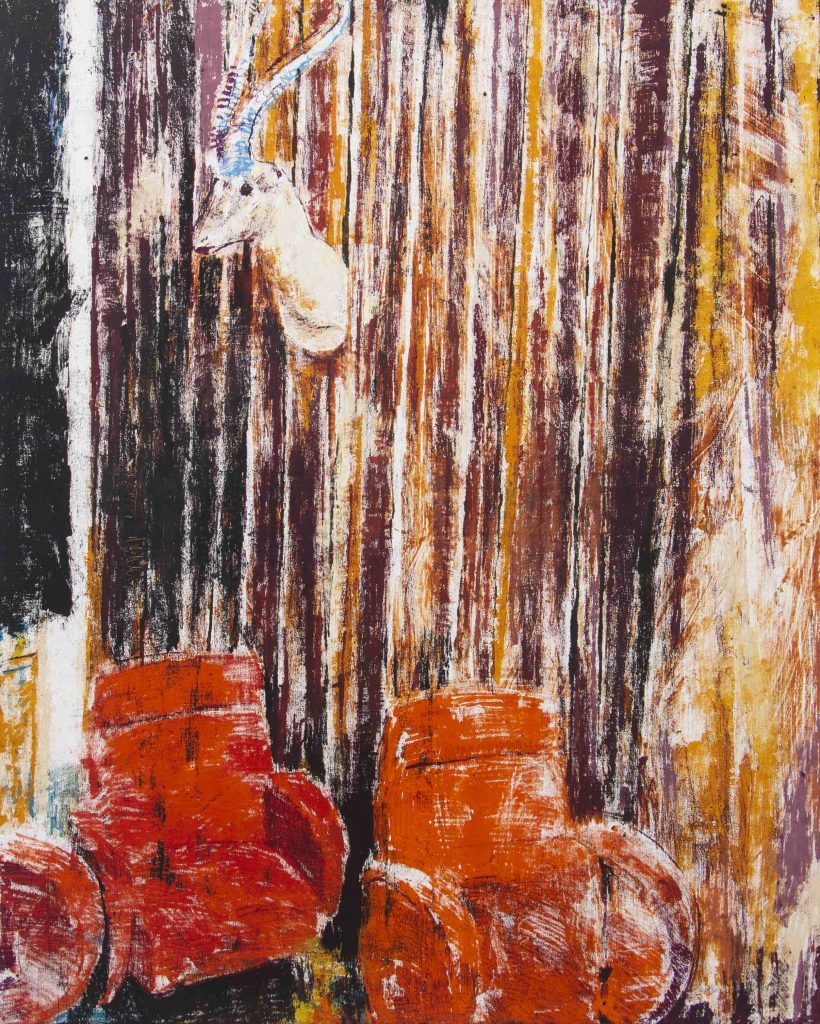
Enoc Perez 2 via Giovanni Francesco Napione, Turin Casa Mollino (as restored by Fulvio Ferrari)2019
olio su tela / oil on canvas 152,4 x 121,9 cm © Enoc Perez
The show will begin with glimpses of Mollino’s last, mysterious residence in Via Napione, Turin – now a museum – as transformed by Perez’s brush and Schindler’s lens, and end with Mollino’s own photographs of models, which blur into the enigmatic essence of the imaginary they inhabit. Since the late 1990s, NYC-based Puerto Rican artist Enoc Perez has been investigating iconic buildings of the twentieth century and the role they have taken on in the popular imagination, as social metaphors of fascination and beauty. But at the same time, what seems to float up out of his paint is the ghostly substance of images: symbols that time has transfigured and transported into a vaguer, even dream-like dimension. Collezione Maramotti already holds several works by this artist, including a diptych of Casa Malaparte made for a temporary exhibition in 2008 and now on permanent display.
In September 2019, Perez visited Casa Museo Mollino and took pictures of its interiors, using them as the basis for several new large-scale paintings made specifically for this exhibition.
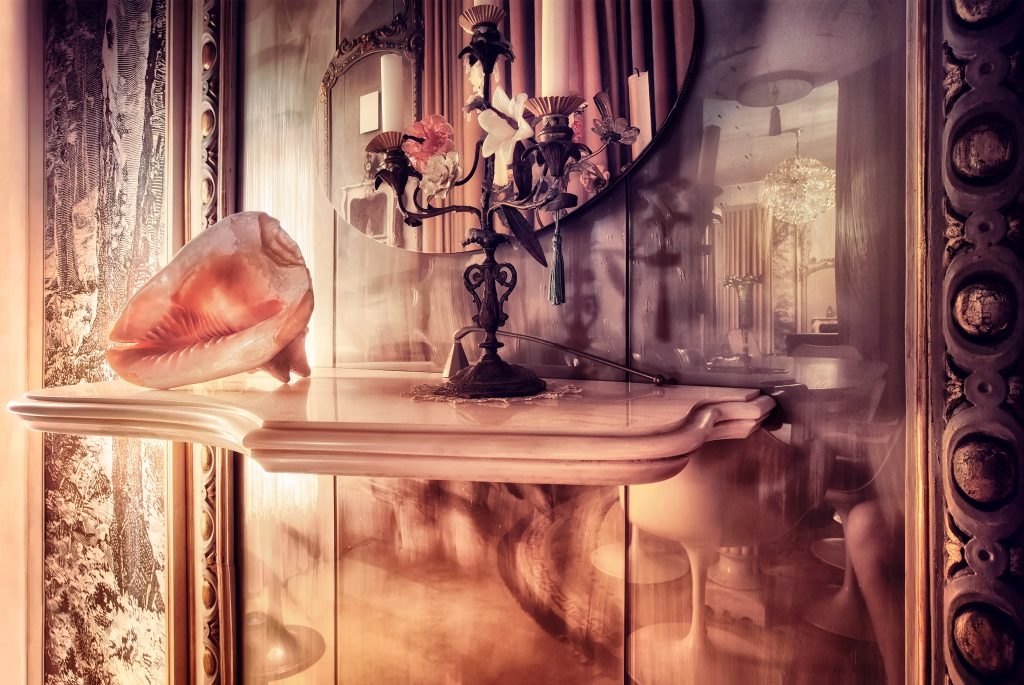
Brigitte Schindler Perché tu sai che posso guardare dietro le tende degli specchi 2019
stampa a colori su carta cotone © Brigitte Schindler
The same flat has served as inspiration for Brigitte Schindler, whose photographic adventure of the past three years has yielded evocative images and startling visions of its interiors, full of significant details. Schindler’s photographs – exhibited here for the first time – capture the suspended mystery of these spaces, the subtle connections between the objects that Mollino carefully chose and arranged. Through a sophisticated balance of mirrors, reflections, metamorphoses and revelations, her visions lead the careful observer along an aesthetic and conceptual path to discover the complex world of Carlo Mollino, a multifaceted twentieth-century figure famous for his work in architecture, photography, design, and more.
![Carlo Mollino [Senza titolo] / [Untitled] 1956-1962 stampa a colori?Courtesy Museo Casa Mollino, Torino](https://fadmagazine.com/wp-content/uploads/8.-Carlo-Mollino-Senza-titolo-1956-62-stampa-a-colori-Courtesy-Museo-Casa-Mollino-Torino-742x1024.jpg)
Carlo Mollino [Senza titolo] / [Untitled] 1956-1962 stampa a colori Courtesy Museo Casa Mollino, Torino
Mollino (1905-1973) practised photography throughout his life, starting in childhood. In his hands, it became a tool for creating a different, alternative reality. The female body was a recurring theme from his earliest portraits, inspired by Surrealism, to his Polaroids of nudes from the 1960s. Mollino chose and prepared the settings, objects, clothing, and accessories with scrupulous care, placing his models in a unique, meticulously designed space that exalts their beauty and underscores the iconography. With a visionary, experimental gaze, he composed sophisticated, complex images that are the female counterpart to his existence, an “army of butterflies” meant to complete him and accompany him even into the next world. Mollino’s last flat on Via Napione, which he never really lived in and always kept a secret, was rarely used as a setting for his photographs; it was a private realm, conceived and designed down to the last detail to reflect his vision of the world. Travelling an eclectic path on which content always preceded form and form was never predictable, and moving from the darkroom of photography to the dark rooms – the hidden, secret spaces – of his dwellings (especially the last), Mollino worked with the substance of this “necessary parenthesis” called life, exploring the beauty of nature (including human nature) to explore the deeper meaning of existence in our time and extend it into the hereafter. In addition to the subject of the works on view – Mollino and his sophisticated, complex imaginary – the guiding theme that links these three artists together is one of transformation and visionary creation.
Perez turns buildings and rooms into paintings, working from photographic images and adding new levels of interpretation and meaning. The utopia that architects strive for in their designs is shared by the artist within the language of painting, with the same expressive significance.
Mollino conceptually and physically constructs worlds/houses as settings for his photographs of female bodies and in preparation for his afterlife. Each object and detail within them is a symbol and spark of stories and allusions. Adopting a highly structured approach and a style that is as composed as it is radical, he combined extraordinary technical skill with a spiritual bent to craft visionary scenarios and narratives, often difficult to decipher and always rich in meaning.
Schindler focuses on the essence of seemingly insignificant details, on how they can become clues and keys to unlock a magical door of the gaze, leading into new “rooms of vision.” Each shot sums up the mise-en-scène for a story that unfolds through the objects of this world, through a shift in how they are perceived.
Mollino/Insides 19th April – 26th July 2020 at Collezione Maramotti collezionemaramotti.org
The exhibition will be accompanied by a book with essays by Mario Diacono and Fulvio Ferrari and a text by Enoc Perez.
About The Artists
Enoc Perez (b. 1967 in San Juan, PR), lives and works in New York.
Perez began painting at the age of eight. He studied at the Pratt Institute in Brooklyn, earning his BFA in 1990, then at Hunter College in New York, earning his MFA in 1992. His solo shows have included: Ben Brown Fine Arts, London (2019); Dallas Contemporary, Dallas (2018); UTA Artist Space, Los Angeles (2017); Brand New Gallery, Milan (2017); Peter Blum Gallery, New York (2015); Galerie Nathalie Obadia, Paris (2015, 2013); Harper’s Books, New York (2014); Thomas Ammann Fine Arts AG, Zurich (2014); Acquavella Galleries, New York (2013); Corcoran Art Gallery, Washington D.C. (2012); Faggionato Fine Arts, London (2011, 2008); Galerie Michael Janssen, Berlin (2010); Mitchell-Innes & Nash, New York (2009); Collezione Maramotti, Reggio Emilia (2008); Museum of Contemporary Art, North Miami (2007). His works have been featured in group shows at many museums and galleries, including: König Galerie, Berlin (2017); Pavillon de l’Arsenal, Paris (2015); Collezione Maramotti, Reggio Emilia (2012, 2009); Museum of Contemporary Art, Chicago (2012); Gagosian Gallery, Los Angeles (2010); Aldrich Contemporary Art Museum, Ridgefield, Connecticut (2008); Triennale Bovisa, Milan (2007); UCLA Hammer Museum, Los Angeles (2004); Centre Pompidou, Paris (2002).
Brigitte Schindler (b. 1972 in Munich), lives and works in Munich and Turin. After studying at Ludwig Maximilian University of Munich and New York Institute of Photography, she began exhibiting in Germany in 2012, at Nicola Leeb’s exhibition space, Munich (2012) and Villa Kustermann, Tutzing (2013). In 2014 she participated in Art Monaco 14 at the Grimaldi Forum, Monte Carlo. In 2015 she showed her work at Finter Bank in Lugano and Kolonial in Munich, and her photographs were selected for the Night Photography Collection of the 5th Annual Exposure Award at the Louvre in Paris. Her photographs have been exhibited in Italy since 2016 at Galleria OpenArt in Milan (2016); Paratissima, Turin (2018, 2019); and Galleria Roccavintage, Turin (2018, 2019). Her first book, Torino ti amo, was published in 2019 by Edizioni del Capricorno, Turin.
Carlo Mollino (Turin, 1905-1973) was an architect, designer, photographer, writer, skier, race car driver and aerobatic pilot. His famous architectural designs include the Società Ippica Torinese building (1936-1940), the Slittovia del Lago Nero ski lift (1946-1947), Casa del Sole in Cervinia (1955), and the Palazzo degli Affari (1964-1972) and Teatro Regio in Turin (1965-1973). From the 1930s on, Mollino also designed furnishings – often one-of-a-kind pieces or limited editions – that combined traditional craftsmanship with experimental materials and technologies, like cold-molded plywood, which he began using for chairs and tables in the 1940s. In 1910 his father set up a darkroom in the family home in Rivoli. It was here that Carlo learned the rudiments of photography, and his first published photographs date to the 1930s. He experimented with different cameras (Leica, Minox, and even Polaroid, becoming one of the earliest adopters) and various formats, shooting in both black-and-white and colour; though he considered himself neither a photographer nor an artist, he pursued an in-depth exploration of the medium in terms of both practice and theory. In his essay “Message from the Darkroom” (1949), he called photography “a fake document, more or less consciously fabricated and chosen with tendentious, personal aims, skilfully rigged through elisions, juxtapositions, and selections that transfigure it, in short a document captured in such a way that it has only the appearance of objectivity.” Mollino used photography as a tool for transforming the world, for crafting a biography full of poetry and metamorphosis. ?From the 1930s until his death, Mollino used various residences in Turin as backdrops for his portraits of “female bodies,” including Casa Miller (1936-1942), Villa Scalero (1956-1962) and Villa Zaira (1962-). In 1968 he completed Villa Avondo in Via Napione, where he took only a few polaroids, but designed a secret home for his spirit after death.
